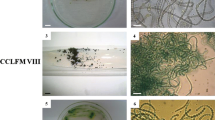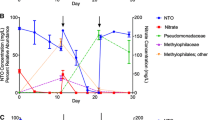Abstract
A stable mixed bacterial culture was obtained by chemostat enrichment using dimethyl-sulphoxide as a carbon and energy source. This culture could not only rapidly oxidize dimethyl-sulphoxide but also dimethyl-sulphide. Enzyme determinations indicated that an important part of it consisted of methylotrophs, which assimilated carbon via the serine pathway. Indeed plate counts revealed the majority of the community to be a Hyphomicrobium species. This organism, designated Hyphomicrobium EG, is an obligate methylotroph which can only grow aerobically on several different C1-compounds. Its performance on dimethyl-sulphoxide was compared with that of the community and of another recently isolated strain, Hyphomicrobium S. The mixed culture, Hyphomicrobium EG and Hyphomicrobium S had a μmax of 0.08, 0.08 and 0.014 h-1 respectively. The KS for dimethyl-sulphoxide was the same for all three cultures (3–6 μM), whereas that for dimethyl-sulphide of Hyphomicrobium EG after growth on dimethyl-sulphoxide was 3-fold higher than that of the other two cultures (48 and 16 μM respectively). After growth on dimethyl-sulphide it improved to 3 μM. Dimethyl-sulphide respiration was maximal at a concentration of 100 μM; higher concentrations were inhibitory. One of the accompanying organisms, a pink methylotroph, was able to derive energy from the oxidation of thiosulphate. Available cultures of Thiobacillus MS1 that were reported to be able to utilize dimethyl-sulphide could no longer metabolize this compound.
Similar content being viewed by others
References
Andreae, M. O. (1980) Dimethyl-sulfoxide in marine and freshwaters. Limnol. Oceanogr. 25: 1054–1063
Andreae, M. O. & Raemdonck, H. (1983) Dimethyl-sulphide in the surface ocean and the marine atmosphere: a global view. Science 221: 744–747
Anness, B. J., Bamforth, C. W. & Wainwright, T. (1979) The measurement of dimethyl-sulphoxide in barley and malt and its reduction to dimethyl-sulphide by yeasts. J. Inst. Brew. 85: 346–349
Anness, B. J. (1981) The determination of dimethyl-sulphoxide in aqueous solution. J. Sci. Food Agric. 32: 353–358
Bamforth, C. W. (1980) Dimethyl-sulphoxide reductase of Saccharomyces spp. FEMS Microbiol. Lett. 7: 55–59
Bamforth, C. W. & Anness, B. J. (1981) The role of dimethyl-sulphoxide reductase in the formation of dimethyl-sulphide during fermentations. J. Inst. Brew. 87: 30–34
Banwart, W. L. & Bremner, J. M. (1976) Evolution of volatile sulfur compounds from soils treated with sulfur-containing organic materials. Soil Biol. Biochem. 8: 439–443
Battat, E., Goldberg, I. & Mateles, R. I. (1974) Growth of Pseudomonas C on C1 compounds: continuous culture. Appl. Microbiol. 28: 906–911
Beudeker, R. F., Cannon, G. C., Keunen, J. G. & Shively, J. M. (1980) Relations between D-ribulose-1,5-bisphosphate carboxylase, carboxysomes and CO2-fixing capacity in the obligate chemolithotroph Thiobacillus neapolitanus grown under different limitations in the chemostat. Arch. Microbiol. 124: 185–189
Beudeker, R. F., Gottschal, J. C. & Kuenen, J. G. (1982) Reactivity versus flexibility in Thiobacilli. Antonie van Leeuwenhoek 48: 39–51
Bont, J. A. M.de, Dijken, J. P.van & Harder, W. (1981) Dimethyl-sulphoxide as a carbon, sulphur and energy source for growth of Hyphomicrobium S. J. Gen. Microbiol. 127: 315–323
Bremner, J. M. & Steele, C. G. (1978) Role of microorganisms in the atmospheric sulfur cycle. Adv. Microb. Ecol. 2: 155–201
Cox, R. B. & Quayle, J. R. (1975) The autotrophic growth of Micrococcus denitrificans on methanol. Biochem. J. 150: 569–571
Dijken, J. P.van, Harder, W., Beardsmore, A. J., & Quayle, J. R. (1978) Dihydroxyacetone: an intermediate in the assimilation of methanol by yeasts. FEMS Microbiol. Lett 4: 97–102
Dodgson, K. S. (1961) Determination of inorganic sulphate in studies on the enzymic and nonenzymic hydrolysis of carbohydrate and other sulphate esters. Biochem. J. 78: 312–319
Friedrich, C. G. & Mitrenga, G. (1981) Oxidation of thiosulfate by Paracoccus denitrificans and other hydrogen bacteria. FEMS Microbiol. Lett. 10: 209–212
Ghisalba, O. & Küenzi, M. (1983) Biodegradation and utilization of monomethyl sulfate by specialized methylotrophs. Experientia 39: 1257–1263. GOA.J. (1953) A microbiuret method for protein determination; determination of total protein in cerebrospinal fluid. Scand. J. Clin. Lab. Invest. 5: 218
Goldberg, I., Rock, J. S., Ben-Bassat, A. & Mateles, R. J. (1976) Bacterial yields on methanol, methylamine, formaldehyde, and formate. Biotechnol. Bioeng. 18: 1657–1668
Gottschal, J. C. & Kuenen, J. G. (1980) Mixotrophic growth of Thiobacillus A2 on acetate and thiosulphate as growth limiting substrates in the chemostat. Arch. Microbiol. 126: 33–42
Houle, M. J., Long, D. E. & Smette, D. (1970) A simplex optimized colorimetric method formaldehyde. Anal. Lett. 3: 401–409
Imai, T. (1983) Odor removal from waste water from kraft pulp mill by activated sludge process. Chemical Abstracts 99: 27403q
Johnson, A. & Quayle, J. R. (1964) Microbial growth on C1-compounds. VI Oxidation of methanol, formaldehyde and formate by methanol grown Pseudomonas AM1. Biochem. J. 93: 281–290
Kelly, D. P. & Wood, A. P. (1982) Autotrophic growth of Thiobacillus A2 on methanol. FEMS Microbiol. Lett. 15: 229–233
Kushelev, Y. V., Libman, B. Y., Mazanko, A. F., Zemlyanskii, V. A. & Boikov, I. G. (1976) A few properties of solutions of dimethyl-sulfide, dimethyl-sulfoxide and water. Sov. Chem. Ind. 10: 775
Large, P. J. & Quayle, J. R. (1963) Microbial growth on C1-compounds: Five enzyme activities in extracts of Pseudomonas AM1. Biochem. J. 87: 386–396
Leach, J. M. & Chung, L. T. K. (1982) Gas concentrations and occupational health in kraft mills. Tappi J. 65, no. 11: 95–98
Ljunggren, G. & Norberg, B. (1943) On the effect and toxicity of dimethyl-sulphide, dimethyl-disulphide and methyl-mercaptan. Acta Physiol. Scand. 5: 248–255
Lorimer, G. H., Badger, M. R. & Andrews, T. J. (1977) D-ribulose-1,5-bisphosphate carboxylase-oxygenase. Anal. Biochem. 78: 66–75
Lovelock, J. E., Maggs, R. J. & Rasmussen, R. A. (1972) Atmospheric dimethyl-sulphide and the natural sulphur cycle. Nature (London) 237: 452–453
Mhatre, S. S., Chetty, K. G. & Pradhan, D. S. (1983) Uncoupling of oxidative phosphorylation in rat liver mitochondria following the administration of dimethyl-sulphoxide. Biochem. Biophys. Res. Commun. 110: 325–331
Nguyen, B. C., Gaudry, A., Bonsang, B. & Lambert, G. (1978) Reevaluation of the role of dimethyl-sulphide in the sulphur budget. Nature (London) 275: 637–639
Patel, R. N. & Hoare, D. S. (1971) Physiological studies of methane and methanol oxidizing bacteria: oxidation of C1-compounds by Methylococcus capsulatus. J. Bact. 107: 187–192
Przyjazny, A., Janicki, W., Chrzanowski, W., & Staszewski, R. (1983) Headspace gas chromatographic determination of distribution coefficients of selected organosulphur compounds and their dependence on some parameters. J. Chromatogr. 280: 249–260
Sivelä, S. & Sundman, V. (1975) Demonstration of Thiobacillus-type bacteria which utilize methyl sulphides. Arch. Microbiol. 103: 303–304
Sivelä, S. (1980) Dimethyl-sulphide as a growth substrate for an obligately chemolithotrophic Thiobacillus. Commentationes physico-mathematicae dissertationes (Helsinki) 1: 1–69
Sörbo, B. H. (1957) A colorimetric method for the determination of thiosulphate. Biochim. Biophys. Acta 23: 412–417
Stirling, D. J. & Dalton, H. (1978) Purification and properties of a NAD(P)+-linked formaldehyde dehydrogenase from Methylococcus capsulatus (Bath). J. Gen. Microbiol. 107: 19–29
Trüper, H. G. & Schlegel, H. G. (1964) Sulphur metabolism in Thiorhodaceae. 1: Quantitative measurements on growing cells of Chromatium okenii. Antonie van Leeuwenhoek 30: 225–238
Vishniac, W. & Santer, M. (1957) The Thiobacilli. Bact. Rev. 21: 195–213
Wood, P. M. (1981) The redox potential for dimethyl-sulphoxide reduction to dimethyl sulphide: Evaluation and biochemical implications. FEBS Lett. 124: 11–14
Author information
Authors and Affiliations
Rights and permissions
About this article
Cite this article
Suylen, G.M.H., Kuenen, J.G. Chemostat enrichment and isolation of Hyphomicrobium EG. Antonie van Leeuwenhoek 52, 281–293 (1986). https://doi.org/10.1007/BF00428640
Accepted:
Issue Date:
DOI: https://doi.org/10.1007/BF00428640




